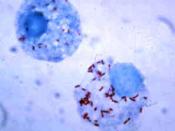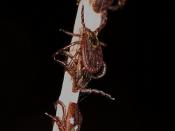What Is Rickettsia?
Rickettsia are bacteria, which are obligate intracellular parasites many disease-causing, that live in vertebrates and are transmitted by bloodsucking parasitic arthropods such as fleas , lice and ticks. Rickettsias are named after their discoverer, the American pathologist Harold Taylor Ricketts, who died of typhus in Mexico after confirming the infectious agent of that rickettsial disease.
Rickettsias unlike other bacteria, but like viruses, they require a living host (a living cell) to survive. Rickettsias from infected vertebrates, usually mammals, live and multiply in the gastrointestinal tract of an arthropod carrier but do not cause disease there; they are transmitted to another vertebrate, possibly one of another species, by the arthropod's mouthparts or faeces.
The cells are extremely small (0.25 um in diameter) rod-shaped, cocci and often pleomorphic microorganisms which have typical bacterial cell walls, no flagella (except for Rickettsiae prowazekii), are gram-negative and multiply via binary fission only inside host cells.
They occur singly, in pairs, or in strands.
Rickettsia and its Diseases
Organism and diseases
Rickettsia
species Disease Natural cycleb Geographic distribution
Vectors Hosts
Typhus group:
Rickettsia prowazekii Epidemic typhus Human body liceHumans Worldwide
Recrudescent typhus None Humans Worldwide
Lice, fleas Flying squirrels Eastern USA
R. typhi Murine typhus Fleas Rodents Worldwide
Fleas Opossums USA
R. felis Murine typhus like Fleas Opossums USA
Spotted Fever group:
R. rickettsiae Rocky Mountain spotted fever Ticks Small mammals, dogs, rabbits, birdsNorth & South America
R. conorii Boutonneuse fever Ticks Rodents, dogs Africa, Southern Europe, India
R. sibirica North Asia tick typhusTicks Rodents Eurasia, Asia
R. japonica Japanese spotted fever TicksRodents, dogs Japan
R. australis Queensland tick typhus Ticks Rodents Australia
R. akari Rickettsialpox Mites House mice, rats Worldwide
Ehrlichioses group:
Ehrlichia chaffeensis Human monocytic ehrlichiosis TicksHumans, deer USA, Europe
Ehrlichia Sp Human granulocytic ehrlichiosis Ticks Humans, deer, rodentsUSA, Europe
Others:
Coxiella burnetiiQ feverTicksSmall mammals, sheep, goats, cattle, dogs Worldwide
Orientia tsutsugamushiScrub typhusMitesRodentsAsia, Indian subcontinent, Australia
History and Facts
Most species are found only in the cytoplasm of host cells, but those which cause spotted fevers multiply in nuclei as well as in cytoplasm. In the laboratory, they may be cultivated in living tissues such as embrocated chicken eggs or vertebrate cell cultures.
Focus is normally put on the vertebrate host, while the arthropod vector is often more important in the natural maintenance of the pathogen. Consequently, co-evolution of rickettsiae with arthropods is responsible for many features of the host-pathogen relationship that are unique among arthropod-borne diseases, including efficient pathogen replication, long-term maintenance of infection, to name a few.
Rickettsial diseases, are widely distributed throughout the world with sporadic and often seasonal outbreaks, from time to time rickettsiae have re-emerged to form epidemics in the human populations.
Throughout history, epidemics of louse-borne typhus have caused more deaths than all the wars combined. The ongoing outbreak of this disease in refugee camps in Burundi involving more than 30,000 human cases is a reminder that Rickettsial diseases can re-emerge in epidemic proportion as a result of the catastrophic breakdown of social conditions. In addition to explosive epidemics, sporadic but limited outbreaks of louse-borne typhus and other Rickettsial diseases have been reported throughout the world. In the United States, a drastic increase of murine typhus in the 1940's, Rocky Mountain spotted fever in the late 1970's, and the human ehrlichioses in the 1990's attests to the potential of this deadly disease.
Host-Parasite Interactions
Rickettsia existence in both mammalian and arthropod hosts serves as an excellent model for the study of complex host-parasite interactions. Rickettsial associations with obligate blood-sucking arthropods represent the highly adapted end-product of biological evolution.
The ecologic separation and reduced selective pressure due to these associations may explain rickettsial genetic conservation. Their intimate relationships with vector hosts are characterized by efficient multiplication, long-term maintenance, and transradial and transovarial transmission.
Although rickettsiae have a symbiotic relationship with their arthropod hosts, in some instances, they act as true parasites for example, members of the Wolbachia and Orientia Tsutsugamushi alter reproduction and manipulate cellular processes in their arthropod hosts, epidemic typhus, Rickettsia Prowazekii, kills its vector, the human body louse
Treatment, Prevention and diagnosis
These diseases present as feverish illnesses after exposure to arthropods or animal hosts or aerosols in endemic areas and are easily misdiagnosed. A delay in diagnosis may be partly responsible for the high mortality from Spotted fever. The spread of the rash is often characteristic: spread from the trunk to the extremities is typical for typhus; spread from the extremities to the trunk is typical for spotted fever.
Laboratory: The use of immunofluorescent antibodies to examine a biopsy can be diagnostic. The organism can be inoculated into tissue culture and grown over 4-7 days but this is very hazardous to personnel.
For the spread of this disease to be curved, proper sanitation is needed. An environment which doesn't promote or sustained rats, arthropods, fleas , lice or anything that house or provides a habitant for the rickettsia.
Immunization against this disease is impossible, it is impossible because there isn't any know vaccine. So other preventive methods would seem like the better alternative in this case since still we cannot be immunized.
Fortunately rickettsia can be treated with pharmaceuticals drugs example Tetracycline or chloramphenicols. Human immunity is important because, following recovery from disease; persons become immune to further infection.
Bibliography
Name of BookAuthor
Patients Care (edition 4)Various Authors
Encarta CD rom 2000Various Authors
http://www.genoscope.cns.fr/externe/
English/Projets/Projet_BU/BU.html
N/A
http://www.factmonster.com/ce6/sci/A0841859.html
N/A
http://www.vh.org/adult/provider/pathology/
/CNSInfDisR2/Text/PInf.VAR.html
N/A


